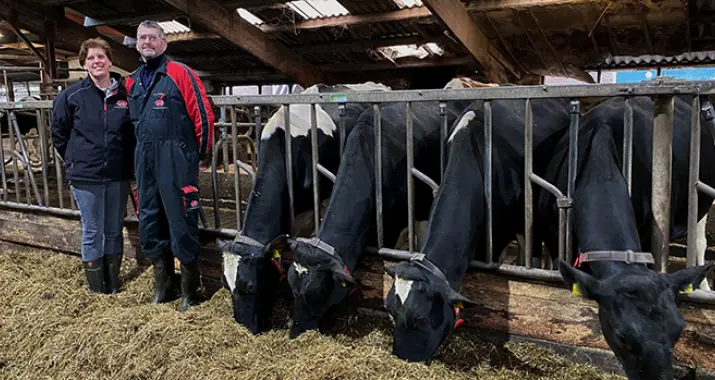The Bouma family gives its dry cows first-rate care and attention
About 80% of all health problems in dairy cows can be traced back to the transition period. This transition from one lactation to the next is not only crucial for the health and longevity of the herd, but also for work pleasure and a healthy balance sheet.

The Netherlands
The Bouma family knows all about it. Marten and Gea milk about 100 cows in the Frisian village of Oldeberkoop. ‘The dry period is the most important time for the cows,’ says Marten. ‘Getting that right can save you a lot of hassle. The feed intake is very important during this period. I want to make sure they eat their fill.’ Each of the Bouma family’s dry cows eats more than 13 kilos of dry matter a day. ‘It’s important that the cows continue to eat large quantities until calving time. The ration is key in that respect. It has to be tasty and as consistent as possible. Diluting the ration with hay or straw that is well mixed guarantees a high feed intake. The cows are put into a straw bedded pen as close to calving time as possible. There, they completely stuff themselves one last time before calving. A high feed intake before calving also ensures a high feed intake after calving. That way, they’re ready to cope well with lactation when it starts.’
The Bouma family works with a specialist from De Heus to determine the ideal ration for the dry period. A high feed intake alone is not sufficient to maintain a proper calcium level. A field trial carried out by De Heus shows that blood calcium levels were too low in more 60% of dairy cows after calving. These animals did not develop milk fever, but they did have a higher risk of developing other health problems. Calcium is crucial in this regard, as it plays an essential role in the functioning of muscles. And muscles are important in a whole range of processes, such as closing the teat after milking, rumen motility and uterine contractions.
To activate the calcium metabolism, the ration must contain sufficient magnesium and vitamin D. And the levels of calcium, phosphorus and potassium must be limited.
‘In addition to a balanced ration,’ Marten adds, ‘cow comfort is extremely important. We had already modified the cubicles for the dairy cows, but in the old shed the dry cows were still lying in cubicles of 1.10 metres,’ says Marten. ‘When we made the cubicles wider and higher here, we immediately noticed that the dry cows were much more prone to lying down.’
The importance of the transition period is clear. ‘If things go well during the dry period,’ Marten says, ‘this prevents problems such as milk fever and ketosis. This saves a lot of time, results in more work pleasure, and generates more milk and certainly more money.’
The Bouma family uses the Prelacto Dry Period Plan.
